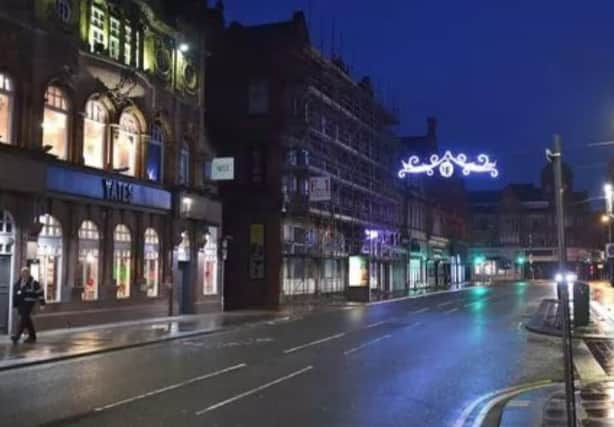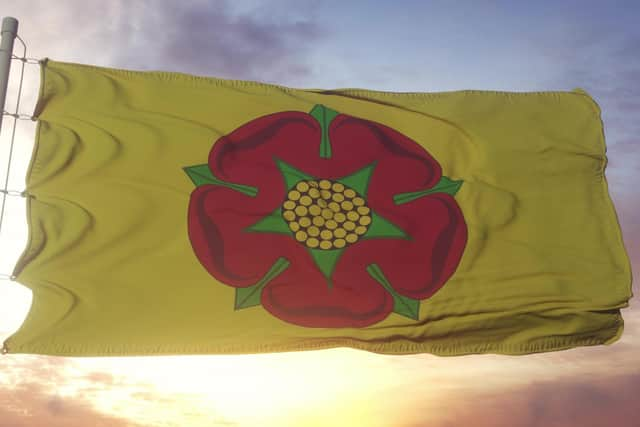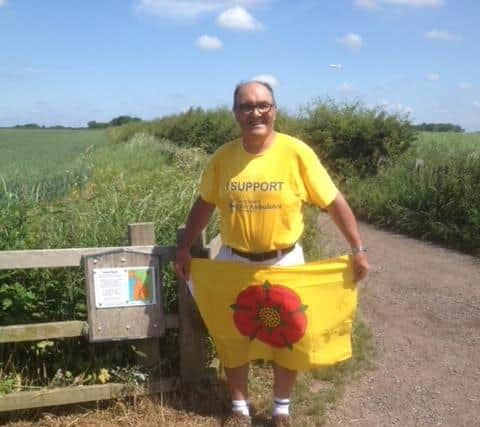"It will be lost if we don’t do something" - Why I'm fighting to keep the real Lancashire alive
and live on Freeview channel 276
Lancashire should start promoting and preserving its true roots before they fade into a forgotten history – with the first step being for Lancashire County Council to drop the word ‘county’ from its name.
That is the call from an organisation dedicated to defending the identity of Lancashire as it existed for almost a millennium before a major shake-up of local government exactly 50 years ago this week changed the perception of the place for all the generations born since.
Advertisement
Hide AdAdvertisement
Hide AdIt was on 1st April, 1974 that a nationwide redrawing of the council map saw Lancashire redefined as a local authority area. County Hall lost huge swathes of the patch for which it had been responsible since its formation in 1889. While the new county council area was intended purely for administrative purposes, it soon became closely – and, for some, inextricably – linked with the concept of Lancashire as a county in itself.
If the geography covered by County Hall today seems sprawling, then 50 years ago there was an even broader panoply of places that came under its umbrella, stretching from the Lake District down to the northern tip of Cheshire – and incorporating the likes of Barrow, Bolton, Southport and Salford.


Cities including Liverpool and Manchester were part of what was – and still is – an historic Lancashire that can be traced back to 1182. However, because they were major areas in their own right, they had their own local authorities, as did even Preston, Blackburn and Burnley, right at the very heart of the county.
However, that division of council responsibility – between those within and those outwith the county authority – did not seem to erode the overreaching Lancashire identity in the way the 1974 changes have since done. For Philip Walsh, chair of the Friends of Real Lancashire, there is now “too much emphasis on Lancashire being the Lancashire County Council area”.
Advertisement
Hide AdAdvertisement
Hide Ad“But the authority only covers about half of the area of the historic county palatine [so called after royal powers were conferred on Lancashire in 1351]. It does not cover the whole south of the county, including such famous Lancashire places as Oldham, Rochdale, St Helens, Bury or Wigan,” Philip, 71, explains.
He says now is the time to end the “confusion” that has reigned since 1974 and make it clear that Lancashire exists within the same expansive borders it always did – whatever local government boundary lines might say. To that end, he would like to see Lancashire County Council become simply “Lancashire Council” to demonstrate that the authority’s patch and the historic county which lends the council its name are far from coterminous.
The 500-strong Friends group is also keen for signs marking the boundaries of ‘historic Lancashire’ to be erected across the county palatine – but has often found itself thwarted by reluctant councils that lie beyond Lancashire’s administrative borders.


“If we had proper signage and maps, that would go a long way to [preserving Lancashire’s heritage],” says Blackpool-born Philip, who now lives in Preston.
Advertisement
Hide AdAdvertisement
Hide AdGently pressed as to whether the real confusion would not come from unpicking half a century of relative certainty about what constitutes Lancashire, Philip says there are plenty of Lancastrians who are still clinging to their traditional identity – in spite of the fact that their towns have long since been formed standalone local authority areas.
“People in Bolton and Wigan talk more about being Lancastrian than people in Preston, Blackpool and Blackburn do," he says. "And you’d be surprised how much interest young people [show in the issue] when we are out and about at events.
"Ultimately, if we as a Friends group don’t shout up about real Lancashire, nobody else will. We’re all volunteers and we promote, protect and preserve the county palatine of Lancashire as it has been for all those hundreds of years – because it’ll be lost if we don’t do something,” warns Philip, who walked the border of ‘real Lancashire’ for charity back in 2018.
There is, however, something that would be lost to Lancashire itself if the historic counties did once again become the defining geography: the entire Forest of Bowland and parts of Pendle around Barnoldswick and Earby, which would all return to – whisper it – Yorkshire.
Advertisement
Hide AdAdvertisement
Hide Ad‘Lancashire should be more like Yorkshire'
It may seem an odd exhortation for someone committed to preserving the heritage of Lancashire to herald how Yorkshire folk do things – but when it comes to promoting a single county identity, Philip Walsh reckons Lancashire could learn a thing or two from its near neighbour and historic rival.
He says that if Lancashire traded off its traditional geography, like Yorkshire does, it would have even more to boast about than the attractions within its arbitrary administrative borders.


“They have this brand, ‘Welcome to Yorkshire’ – and if we had a ‘Welcome to Lancashire’ [across the historic county], we’d be able to push places like Bury, Rochdale and Wigan. Manchester and Liverpool would still probably want to do their own thing, but that [wouldn’t stop us] taking on those places as well.
“Just recently, for instance, a BBC article referred to [the artist] LS Lowry as being born in Salford, Greater Manchester. The Friends group secretary got in touch with them to say Salford might be in Greater Manchester now, but Lowry was born in Lancashire – and he’d be turning in his grave [to hear it being said otherwise].”
Advertisement
Hide AdAdvertisement
Hide AdCausing county confusion was a 'big mistake'
The Identities of England’s traditional counties were “seriously undermined by the ill-conceived way in which local government change in 1974 was handled”. That is according to Peter Boyce, chair of the Association of British Counties (ABC), who says the areas are “an important part of our history, geography, and culture”.
He is encouraging people to do the “most effective thing” they can to promote counties like Lancashire – which he believes is to use it within their postal address.
“It was a huge mistake to call local government areas ‘counties’ and to give any council an historic county name when it had an area radically different to that county," Peter says. “The geography of a thousand years was swept away and replaced by an administrative geography that lasted only 20 years before it started to fall apart. Confusion reigned.
The government actively promotes the celebration of historic counties, which Peter welcomes – but he is calling on ministers to go much further in their support.
Advertisement
Hide AdAdvertisement
Hide Ad“[They] should back this up by rectifying the mistake made in 1974," he says. "Local government needs a set of terminology and names which give it a distinct identity to the historic counties. The term ‘council area’ rather than ‘county’ should be used to refer to local government areas. A council should only make unqualified use of a historic county name if it is close in area to that county.
“Our nation needs a fixed general-purpose geography, a commonly accepted set of names and areas for people to use in all walks of life – travel, business, tourism, addressing, sport, hobbies [and] weather forecasts. The historic counties are the only credible choice for that.
“We know that millions of Britons love their county and we encourage them to promote and celebrate its history and heritage at every opportunity. Embrace your county’s flag – fly it everywhere – [and] join in the celebration of your county’s day,” Peter urges.
Lancashire Day is celebrated on 27th November each year.
What the Government says
In its guidance on celebrating historic counties, the government describes them as “an important element of English traditions which support the identity and cultures of many of our local communities, giving people a sense of belonging, pride and community spirit”.
Advertisement
Hide AdAdvertisement
Hide Ad“They continue to play an important part in the country’s sporting and cultural life as well as providing a reference point for local tourism and heritage. We should seek to strengthen the role that they can play,” the document adds.
Comment Guidelines
National World encourages reader discussion on our stories. User feedback, insights and back-and-forth exchanges add a rich layer of context to reporting. Please review our Community Guidelines before commenting.